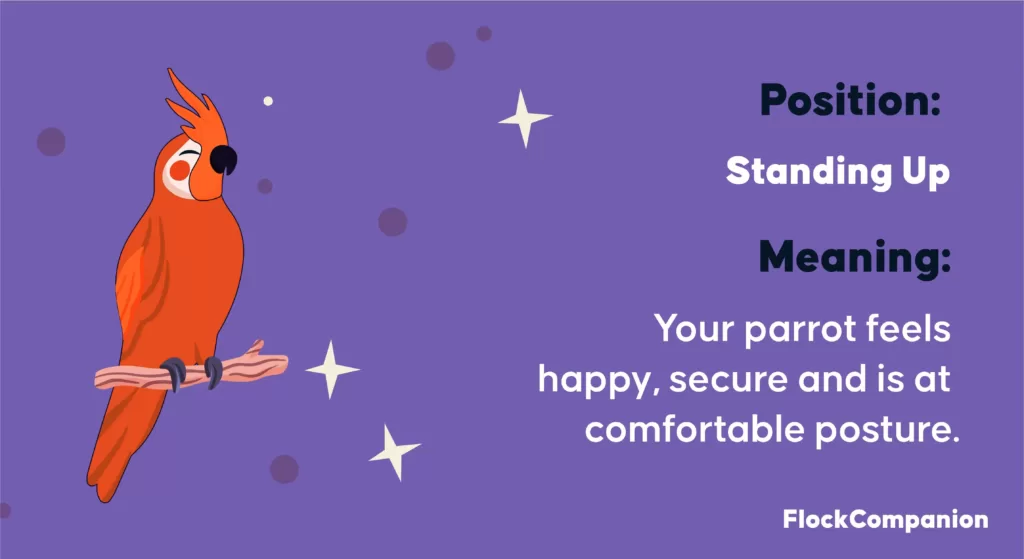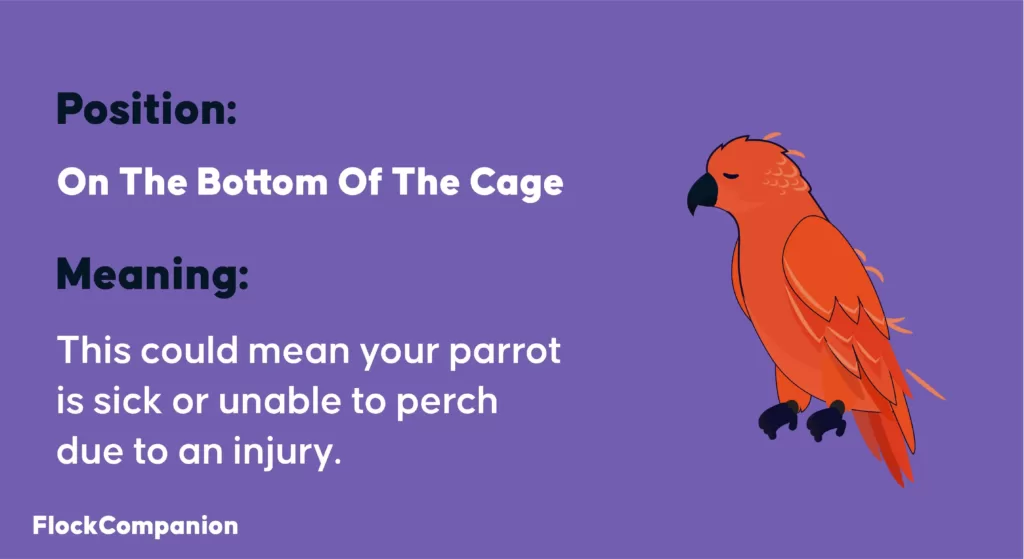You’ve probably noticed your parrot sleeping in various positions. Many of them may look odd while some precarious. But still, you may not be familiar with what those sleeping positions mean.
Parrots typically sleep standing up in an upright position, but their sleeping positions can change depending on their preference at that moment.
Each sleeping position has a different meaning and can help you understand your parrot’s behaviors. When a parrot sleeps on one leg, it is usually to stay warm whereas a parrot that is puffed up while sleeping may be feeling cold.
In this article, I will cover how parrots sleep and the meaning behind their different sleeping positions.
Quick Navigation
What Different Parrot Sleeping Positions Mean?
It is common to see your parrot switch up sleeping positions. One day they are sleeping in a standing-up posture while the next they are upside down.
This may lead you to wonder how parrots sleep and what is the right posture for them. Here are the most common parrot sleeping positions and their meanings:
Parrot Sleeping Standing Up

The standard standing-up posture with the head slightly drooping, is the most common sleeping position in parrots.
It may not look like the most comfortable position to rest, but it is one of the favorites among all parrot species.
Some people worry that their parrots may fall off from their perch at night. But it is not something to get concerned about.
When a parrot is asleep, the weight of its body makes the tendons in its feet tighten, giving it a secure grip on the perch and preventing it from slipping off.
Parrot Sleeping On One Leg

Another common way parrots like to sleep is with one leg tucked inside their feathers. This again may seem like an uncomfortable position to be sleeping in, but parrots have a strong grip.
According to Research Gate, birds including parrots have mechanisms that help them lock their leg joints in place while standing.
So while it may look precarious, this posture requires less energy because the leg is locked in its position.
Sleeping on one leg also helps parrots stay warm in winter. Parrots have feathers all over their bodies, except for their legs and feet.
This can cause heat to escape more easily from those areas. So if a parrot is sleeping on one leg, it is usually to avoid heat loss.
This does not necessarily mean that the parrot is feeling cold. However, it is common for parrots to sleep like this during the winter season. They may also alternate between legs to give each one proper rest.
Parrot Sleeping With One Eye Open

Parrots do not easily trust people or their environment. You may notice your parrot sleeping with one or both eyes partly open mostly during their daytime naps.
In this pose, the parrot is half asleep and watches out for potential threats. They have the uncanny ability to put one-half of their brain to sleep while keeping the other half active and alert.
This is scientifically referred to as Unihemsipheric sleep. When a parrot is sleeping with one eye open, it means they are resting but it is not deep sleep. It is completely normal behavior that you shouldn’t worry about.
Parrot Sleeping Upside Down

Sometimes parrots may choose to snooze while being upside down, kind of like a bat. While it is not a commonly seen sleeping posture, many parrots do sleep upside down while hanging from the cage.
During the bat posture, the parrot will hang to the cage bars using its feet and tuck its head into its wings. Parrots are comfortable in the upside-down position but they may not sleep like that for long durations.
Frankly, it is a matter of having a strong bond with your parrot. When a parrot is sleeping while hanging upside down, it may not be able to take flight quickly if danger comes.
Despite this sense of vulnerability, they may sleep in this posture because they trust you. So, If your parrot hangs upside down, it means it feels safe around you and its environment. It’s a testament to the bond they have established with you and shows that they feel protected.
Parrot Sleeping With Head Down

Parrots look for a cozy spot to hunker down for the night and what could be cozier than their fluffy and soft feathers?
In this position, the parrot turns its head backward and tucks its beak in its feathers, sometimes also fluffing up. This is a common sleeping position for parrots and indicates that the bird is feeling relaxed and comfortable.
However, when a parrot has fluffed up its feathers, it could mean that they are feeling cold. Fluffing up their feathers helps in preserving body heat and allows them to maintain a comfortable temperature during sleep.
Parrot Sleeping On Its Back Or Sides

It can be nice to see your parrot curling up and snuggling next to you in bed. Some parrots may do this when they find a comfy spot to lie down, such as a cushion or bed.
Sometimes, they may even curl up in your hands, which shows they trust you and enjoy your company. If your parrot is sleeping on its back with its feet pointing up, it means that it trusts you and the two of you share a unique bond.
Parrot Sleeping On The Bottom Of Cage

Parrots typically look for a higher spot to perch. It provides them with a good vantage point to know where the dangers might be. So if a parrot goes to the bottom of the cage, it can be a sign that something is amiss.
When a parrot chooses to sleep in one corner of the cage, it could indicate that the bird is unwell, scared, or even injured. Many a time a parrot would not perch when it has an injured foot. You should check on your parrot for any kind of foot injuries and also pay attention to any changes in behavior.
Parrot Sleeping While Puffed Up

When your parrot fluffs up its feathers while sleeping, it usually means that it is feeling cold.
Fluffing up feathers helps parrots regulate their body temperatures. They do this by creating a layer of air between their feathers and skin, which helps them stay warm and cozy.
However, it is important to address this issue and ensure that their environment is not too cold. Parrots don’t do well in extremely cold temperatures. So it’s best to avoid air conditioners if they are sleeping in the same room as you.
That being said, fluffing up feathers can sometimes also indicate that the parrot is sick. If they only puff up during their bedtime, it is okay, but if they’re like that all day, it may be a sign of underlying health issues.
How To Tell If A Parrot Is Sleeping?
Because most parrot species originate in tropical regions, their sleep is based on the light changes in the environment. This means they will go to sleep when it gets dark outside or when you darken their environment.
Before falling asleep, parrots usually go onto their perches to roost. They may roost for about an hour before going off to sleep. You may hear less noise from your parrot but certain sounds which are self-soothing techniques parrots use to get themselves a great night’s sleep.
At this stage, they might be asleep but they’re still in NREM sleep which means they will occasionally take a peek around. It is their instinct to ensure their surroundings are 100% safe before they choose to go into a deep sleep.
When in deep sleep, parrots typically have their eyes closed and maintain an upright posture. You will not hear a peep from them during this period. However, it is important to note that parrots do not sleep through the night.
They do sleep for the majority of that period but may still wake up a few times at night. Nonetheless, you should maintain quiet in their room to provide them with undisturbed sleep.
How To Put Your Parrot To Bed?
Sleep is an important part of a parrot’s well-being. On average, parrots sleep 10-12 hours every day which is almost half a day. So it is important to make sure that you provide the right environment for them to sleep peacefully.
Use White Noise
In addition to keeping the noise down, you can help your parrot sleep better by playing white noise.
White noise is a type of sound that uses different frequencies with equal intensity to block out other noises. These include the sound of water flowing, nature sounds, wind sounds, etc. It is a calming sound that can help parrots relax and unwind.
There are also many apps available that you can use to play white noise in your parrot’s room when they’re roosting.
Adjust Temperatures
It can get chilly around the winter months, especially during the night. I recommend you keep a heating pad for your parrot’s cage as cold can disrupt their sleep. Parrots are most comfy at temperatures around 18 to 22 degrees Celsius or 64 – 72 Fahrenheit.
Keep Perches on Both Sides
Parrots can be picky about the spot they’d like to get their good night’s rest. One day they may roost on one side, the other day they may not want to.
That is why you should keep switching up things in your parrot’s cage to prevent it from getting bored. Some parrots will choose to sleep in one corner of the perch exclusively.
Ensure Darkness
As most parrots originate in tropical regions, they follow a 24-hour light cycle in which they sleep for 12 when it is complete darkness. So turning off all lights and creating a dark environment helps parrots sleep better and ensures their circadian rhythm is not affected.
Healthy Diet
You may not think diet to be directly linked to a parrot’s sleep but it is very closely related.
Parrots that are fed a high-carbohydrate or high-fat diet often have trouble sleeping. This is because sugar can lead to elevated blood sugar levels in parrots and make them unable to relax.
It is essential, that you provide your parrot with healthy greens, fruits, and high-quality pellets. Not only will it improve their health but also help in better sleep.






